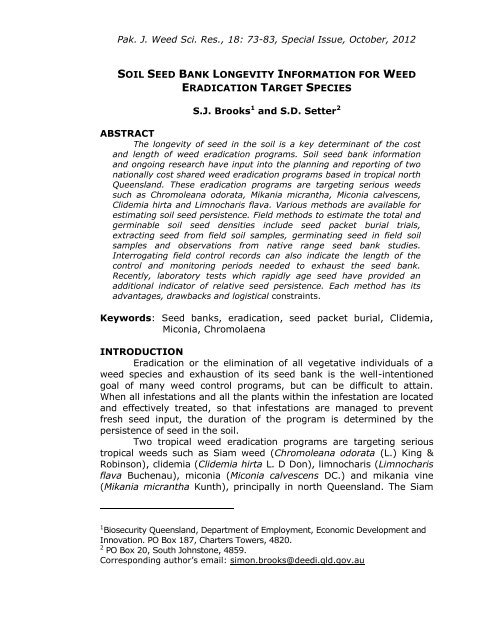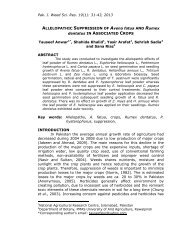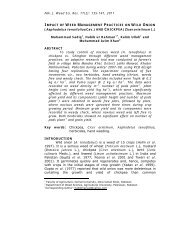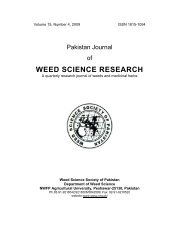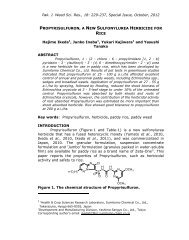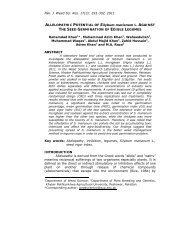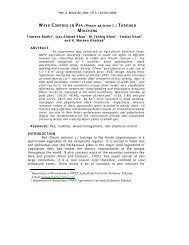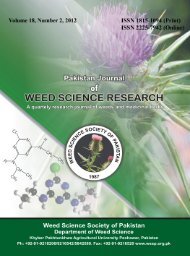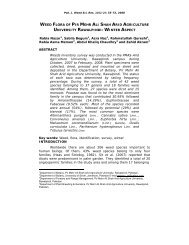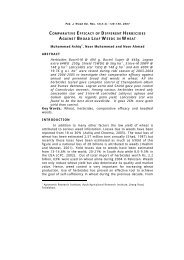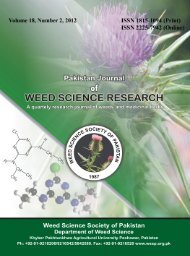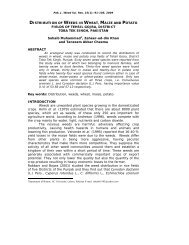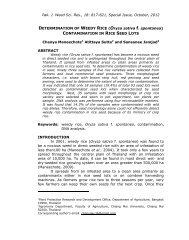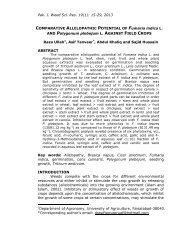soil seed bank longevity information for weed ... - Wssp.org.pk
soil seed bank longevity information for weed ... - Wssp.org.pk
soil seed bank longevity information for weed ... - Wssp.org.pk
Create successful ePaper yourself
Turn your PDF publications into a flip-book with our unique Google optimized e-Paper software.
Pak. J. Weed Sci. Res., 18: 73-83, Special Issue, October, 2012SOIL SEED BANK LONGEVITY INFORMATION FOR WEEDERADICATION TARGET SPECIESS.J. Brooks 1 and S.D. Setter 2ABSTRACTThe <strong>longevity</strong> of <strong>seed</strong> in the <strong>soil</strong> is a key determinant of the costand length of <strong>weed</strong> eradication programs. Soil <strong>seed</strong> <strong>bank</strong> <strong>in<strong>for</strong>mation</strong>and ongoing research have input into the planning and reporting of twonationally cost shared <strong>weed</strong> eradication programs based in tropical northQueensland. These eradication programs are targeting serious <strong>weed</strong>ssuch as Chromoleana odorata, Mikania micrantha, Miconia calvescens,Clidemia hirta and Limnocharis flava. Various methods are available <strong>for</strong>estimating <strong>soil</strong> <strong>seed</strong> persistence. Field methods to estimate the total andgerminable <strong>soil</strong> <strong>seed</strong> densities include <strong>seed</strong> packet burial trials,extracting <strong>seed</strong> from field <strong>soil</strong> samples, germinating <strong>seed</strong> in field <strong>soil</strong>samples and observations from native range <strong>seed</strong> <strong>bank</strong> studies.Interrogating field control records can also indicate the length of thecontrol and monitoring periods needed to exhaust the <strong>seed</strong> <strong>bank</strong>.Recently, laboratory tests which rapidly age <strong>seed</strong> have provided anadditional indicator of relative <strong>seed</strong> persistence. Each method has itsadvantages, drawbacks and logistical constraints.Keywords: Seed <strong>bank</strong>s, eradication, <strong>seed</strong> packet burial, Clidemia,Miconia, ChromolaenaINTRODUCTIONEradication or the elimination of all vegetative individuals of a<strong>weed</strong> species and exhaustion of its <strong>seed</strong> <strong>bank</strong> is the well-intentionedgoal of many <strong>weed</strong> control programs, but can be difficult to attain.When all infestations and all the plants within the infestation are locatedand effectively treated, so that infestations are managed to preventfresh <strong>seed</strong> input, the duration of the program is determined by thepersistence of <strong>seed</strong> in the <strong>soil</strong>.Two tropical <strong>weed</strong> eradication programs are targeting serioustropical <strong>weed</strong>s such as Siam <strong>weed</strong> (Chromoleana odorata (L.) King &Robinson), clidemia (Clidemia hirta L. D Don), limnocharis (Limnocharisflava Buchenau), miconia (Miconia calvescens DC.) and mikania vine(Mikania micrantha Kunth), principally in north Queensland. The Siam1 Biosecurity Queensland, Department of Employment, Economic Development andInnovation. PO Box 187, Charters Towers, 4820.2 PO Box 20, South Johnstone, 4859.Corresponding author’s email: simon.brooks@deedi.qld.gov.au
74 S.J. Brooks and S.D. Setter. Soil <strong>seed</strong> <strong>bank</strong> <strong>longevity</strong>…<strong>weed</strong> eradication program commenced in 1994 when this serious <strong>weed</strong>was discovered on mainland Australia. The ‘Four Tropical Weeds’Eradication Program (targeting clidemia, miconia, mikania vine andlimnocharis) commenced operations in late 2003 (Erbacher et al.,2008). Single infestations of the shrubs Miconia racemosa (Aubl.) DC.and Miconia nervosa (J.E. Smith) Triana. were identified in northQueensland in 2002 and 2004 respectively, and are included ineradication program as they co-occur with M. calvescens infestations.Both eradication programs receive funding via national costshare arrangements from the Federal, Queensland and other stategovernments potentially affected by the <strong>weed</strong>s. The programs arerequired to estimate a timeframe and resources required <strong>for</strong> eradication,and knowledge of <strong>seed</strong> persistence is an important component of suchestimates. Ongoing research into <strong>seed</strong> persistence also has input intoactivities of and reporting <strong>for</strong> the two programs. In<strong>for</strong>mation on <strong>soil</strong><strong>seed</strong> <strong>bank</strong> persistence may also help in<strong>for</strong>m decisions about wheninfestations are declared eradicated. This paper summarises sources of<strong>seed</strong> <strong>bank</strong> <strong>in<strong>for</strong>mation</strong>, what is known about the main target speciesand what are some of the constraints in investigating <strong>seed</strong> persistence.Since much of this research in ongoing, an overview of trials ispresented.Sources of Seed Bank In<strong>for</strong>mationIn<strong>for</strong>mation on <strong>soil</strong> <strong>seed</strong> <strong>bank</strong> persistence can be sought fromthe invasive and native ranges across of the targeted species.Repeated collection of <strong>soil</strong> samples from within infestations is acommon method <strong>for</strong> estimating rates of <strong>seed</strong> <strong>bank</strong> depletion. Thisprocess is suited to eradication programs where field crews aim toprevent fresh <strong>seed</strong> production by controlling plants. Ideally, thesampled areas should contain a high initial <strong>seed</strong> density and they needto be accessible and locatable <strong>for</strong> the duration of the sampling, whichmay take many years. Such studies are enhanced by data on the initial<strong>weed</strong> population and ongoing <strong>seed</strong>ling emergence. Methods toestimate the total <strong>seed</strong> <strong>bank</strong> include physical (including sieving) orchemical extraction of <strong>seed</strong> from field <strong>soil</strong> samples. Soil samples canalso be collected from infestations over time and kept underfavourable conditions, such as in a glasshouse, to determine thegerminable <strong>seed</strong> <strong>bank</strong>.Seed can also be buried in permeable packets filled with field<strong>soil</strong> and the packets retrieved over time to test <strong>seed</strong> viability. Thesetrials eliminate the factors of <strong>seed</strong> immigration and emigration, sodepletion of a set number of <strong>seed</strong>s can be investigated (Van Mourik etal., 2005). Depletion can occur through <strong>seed</strong> death or germination.Germination can hasten the decline, particularly in packets exposed tolight on the <strong>soil</strong> surface. Biotic agents such as <strong>soil</strong> fauna, bacteria and
Pak. J. Weed Sci. Res., 18: 73-83, Special Issue, October, 2012 75fungi may cause <strong>seed</strong> depletion, but the packets may concentrate<strong>seed</strong>, making fungal attack more likely (Van Mourik et al., 2005). Seedis germinated at the commencement of packet trials to provide dataon initial viability and germinability.Both eradication programs maintain databases which record fieldvisit <strong>in<strong>for</strong>mation</strong> (including plant absence). To report on eradicationprogress each infestation or management area is allocated to a ‘control’status if any plants were present at any time during the year. If noplants were found in a year then a ‘monitoring’ status is allocated. Thetime spent in the control phase provides an indication of the persistenceof viable <strong>seed</strong>s over a variety of infestations. The length of themonitoring phase provides a buffer period between the control phaseand declaring eradication, during which <strong>seed</strong>lings could emerge from the<strong>seed</strong> <strong>bank</strong>. Interrogating field control records can indicate the length ofthese phases across multiple infestations. Seed persistence can varybetween populations and locations (Panetta, 2004).Recently, a procedure undertaken in a controlled laboratoryenvironment has provided an additional indicator of <strong>weed</strong> <strong>seed</strong>persistence (Long et al. 2008). The controlled aging test (CAT)determines number of days it takes <strong>for</strong> the viability of <strong>seed</strong>s to declineto 50% (P 50 ) when exposed to 65% humidity and 45 o C. The following<strong>seed</strong> persistence terms, P 50 values and equivalent periods of fieldpersistence are adapted from Long et al. (2008):Transient <strong>seed</strong> <strong>bank</strong>s, P 50
76 S.J. Brooks and S.D. Setter. Soil <strong>seed</strong> <strong>bank</strong> <strong>longevity</strong>…Bay) identified in 1994 and germinated in a glasshouse. Seedlingemergence equivalent to a <strong>seed</strong> density of 9050 <strong>seed</strong>s/m 2 was recorded(M. Setter, unpublished data). Samples collected and germinated fromthe same area seven years later revealed 99.9% fewer <strong>seed</strong>s (12.5<strong>seed</strong>s/m 2 ); during this time <strong>seed</strong> input was believed to have beenprevented. No <strong>seed</strong> germinated from samples collected 12 years afterdiscovery. In 2000, a trial in which permeable packets were filled with50 locally obtained Siam Weed <strong>seed</strong>s and buried at 0, 2 and 10 cm wasestablished near South Johnstone (M. Setter pers comm. 2008). In thefirst four years of the trial the surface-situated <strong>seed</strong> showed thegreatest run down, after five years of annual retrievals 1.5% of <strong>seed</strong>s(across all depths) was viable and no viable <strong>seed</strong> was found after sevenyears when the final sample was taken.There has also been interest in Siam <strong>weed</strong> <strong>seed</strong> <strong>longevity</strong> in thedrier tropical Tableland and Townsville areas. As the source of theseinfestations is not confirmed, there may be genetic or environmentaldifferences to the wet tropics infestations that could influence <strong>seed</strong><strong>longevity</strong>. From 2003 annual <strong>soil</strong> samples were collected from aninfestation in the Upper Herbert catchment and <strong>seed</strong>ling recruitmentwas recorded on transects in this infestation. No <strong>seed</strong>lings emergedfrom the 5 th year of sampling and no <strong>seed</strong>lings were noted after fouryears of monitoring the field transects. A buried <strong>seed</strong> <strong>longevity</strong> trialwas established at Charters Towers in December 2008. Seed from aTownsville infestation was buried in fine nylon mesh packets placed at0, 3 and 13 cm within a holed pipe (container) filled with <strong>soil</strong>. The topof the containers was covered with 30% shade cloth to contain thepackets and lower the effect of sunlight on the nylon surface packets.The trial includes four <strong>soil</strong> types with grassed or bare ground subplots.Sufficient containers were buried to allow <strong>for</strong> six monthlyretrievals <strong>for</strong> two years, annual retrievals between two and sevenyears and three extra retrievals if required after seven years.Field data, field samples and a buried <strong>seed</strong> trial indicate thatSiam <strong>weed</strong> develops a long lived <strong>seed</strong> <strong>bank</strong>, with most viable <strong>seed</strong>exhausted between four and eight years.MiconiaMeyer (2010) reported on the density of Miconia <strong>seed</strong>sgerminated from <strong>soil</strong> samples collected on Raiatea in 1992, 1993,1995 and 2008. From 4500 <strong>seed</strong>s/m 2 in 1993 there was a rapiddecline in germinable <strong>seed</strong> density to below 1000 <strong>seed</strong>s/m 2 in 1995;however, <strong>seed</strong>s germinated in the 2008 samples. The emergence of<strong>seed</strong>lings 16 years after the removal of locally reproductive plantsindicates a very persistent <strong>seed</strong> <strong>bank</strong>. Meyer (2010) also reports <strong>soil</strong><strong>seed</strong> densities approaching 50 000 <strong>seed</strong>/m 2 under Tahitianinfestations.
Pak. J. Weed Sci. Res., 18: 73-83, Special Issue, October, 2012 77Miconia has been identified at 57 locations in Queensland and NewSouth Wales, though naturalisation has only been recorded at 28locations (Brooks and Jeffery, 2010). Most naturalised infestations are ina control phase, some <strong>for</strong> at least 10 years. For example, following theremoval of mature miconia from a small infestation near Julatten in2001, local <strong>seed</strong>ling recruitment has been observed in 2011 (K.Erbacher, Pers. Comm., 2011). Additional <strong>seed</strong> input is unlikely as fieldcrews search hundreds of hectares annually around this location <strong>for</strong>another eradication target without finding any mature miconia (Brookset al., 2009). Control records indicate that M. nervosa and M.racemosa have developed persistent <strong>seed</strong> <strong>bank</strong>s (Brooks et al., 2009),but no further <strong>seed</strong> studies have been undertaken and no studies of<strong>seed</strong> persistence have been identified in their native ranges.At a large ‘El Arish’ miconia infestation, sampling (20 surfacecores each from 1 m 2 plots replicated across six blocks) and sieving ofthe <strong>soil</strong> samples was conducted annually between 2004 and 2008.Samples can be taken five more times at greater than yearly intervals.There has been no decline in the number of <strong>seed</strong>s extracted (viasieving) from samples collected between 2004 and 2008, though theviability of the extracted <strong>seed</strong>s is being assessed; the <strong>seed</strong>s extractedequate to a total field density of less than 2000 <strong>seed</strong>s/m 2 (S. Brooksunpublished data). A few <strong>seed</strong>lings emerged in the sampled areaannually from 2005 to 2010. The closest mature trees were removedin September 2004.A buried <strong>seed</strong> packet trial was established in October 2010 in thearea used <strong>for</strong> the wet tropics Siam <strong>weed</strong> buried packet trial at SouthJohnstone. Fifty miconia <strong>seed</strong>s were placed into 180 µm stainless steelmesh packets. Packets were placed a holed container filled with <strong>soil</strong> atthe <strong>soil</strong> surface and buried 3 and 10 cm below the <strong>soil</strong> surface.Containers will be removed every six months <strong>for</strong> two years and annuallybetween 2 and 16 years. The trial design allows <strong>for</strong> seven additionalretrievals after 16 years if viable <strong>seed</strong> remains and the retrievalschedule can be altered during the trial. The containers were coveredwith 30% shade cloth to contain the packets and lower the effect ofsunlight on the surface packets until grasses shaded the containers.ClidemiaMendes-Rodrigues et al. (2008) assessed the viability of fourclidemia <strong>seed</strong> samples collected near Uberlandia (Brazil), two freshcollections, one sample stored under laboratory conditions <strong>for</strong> twoyears and one buried in permeable packets in local <strong>soil</strong> <strong>for</strong> two years.Germination from all samples was similar and high (range 87.7 to94.2%); 93.1% of <strong>seed</strong> germinated after being recovered from thepackets. In the same area of Brazil, Pereira-Diniz and Ranal (2006)
78 S.J. Brooks and S.D. Setter. Soil <strong>seed</strong> <strong>bank</strong> <strong>longevity</strong>…found small numbers of germinable clidemia <strong>seed</strong> at various <strong>soil</strong>depths from the surface to 30-35 cm in microhabitats of a gallery<strong>for</strong>est; concluding that species found in the deeper samples <strong>for</strong>med apersistent <strong>seed</strong> <strong>bank</strong>. In the Bragantina area of Brazil, Vieira andProctor (2007) found clidemia <strong>seed</strong> made considerable contributions tothe total <strong>soil</strong> <strong>seed</strong> <strong>bank</strong> and <strong>seed</strong> rain in a primary <strong>for</strong>est and in 5, 10and 20 year old secondary <strong>for</strong>est plots, although clidemia was notrecorded in censuses of nearby plants. Medeiros (2004) reportedevidence of a widespread and persistent <strong>seed</strong> <strong>bank</strong>, when clidemia<strong>seed</strong>lings emerged in plots on Hawaii with limited <strong>seed</strong> input. Furtheranecdotal reports indicate that clidemia develops a <strong>seed</strong> <strong>bank</strong> thatpersists <strong>for</strong> at least 3 years (Medeiros, 2004) and <strong>seed</strong>ling emergencemay occur up to 10 years after the removal of mature plants (Smith,1992). Overseas field observations indicate that clidemia can quicklydevelop a persistent <strong>seed</strong> <strong>bank</strong> in a variety of vegetation types, evenwhen the frequency of mature plants is low.Clidemia is known only at one location in Australia. Thisinfestation was discovered and first controlled in 2001, with <strong>seed</strong>lingrecruits from an active <strong>seed</strong> <strong>bank</strong> recorded in 2011 (K. Erbacher PersComm., 2011). Within the core area of highest recruitment there hasbeen limited fresh <strong>seed</strong> produced since 2004 and probably back to 2001(Brooks et al., 2009). Clidemia <strong>seed</strong> was included in the buried packettrial established with miconia <strong>seed</strong> in October 2010 and using thesame methodology described above. This trial will complement fieldpopulation run down data and provide <strong>in<strong>for</strong>mation</strong> about <strong>seed</strong>persistence at recently discovered patches.Mikania vineIt was generally thought that Mikania <strong>seed</strong>s would persist <strong>for</strong>around seven years (Brooks et al., 2008); however, few publishedstudies have been identified. Buried <strong>seed</strong> trials have not been conductedlocally as <strong>seed</strong> is rarely encountered in the field and is destroyedimmediately when found. A few samples have been collected in the past13 years but their viability has been low (1 to 18%). There is also areluctance to cultivate specimens under quarantine conditions, given the<strong>seed</strong>s are wind dispersed and known distribution in Australia is limitedto 15 infestations around three locations. With few new discoveries andover half of the infestations in a monitoring phase, the eradication ofthis <strong>weed</strong> is going well (Brooks et al. 2008). Recently, Macanawai et al.(2010) conducted a controlled aging test (CAT) on Mikania vine <strong>seed</strong>from Fiji and found it fitted into the short term persistence category,with P 50 = 48 days.LimnocharisOrtiz Domínguez and González (2001) collected <strong>soil</strong> <strong>seed</strong> <strong>bank</strong>samples from nine rice paddy areas near Calabozo, Venezuela. Some
Pak. J. Weed Sci. Res., 18: 73-83, Special Issue, October, 2012 79of their samples were germinated in trays in a humid laboratoryenvironment and some where chemically separated to determine thetotal <strong>seed</strong> <strong>bank</strong>. They reported that limnocharis <strong>for</strong>med a largeproportion of total <strong>seed</strong>s present (55.7% of total <strong>weed</strong>s) in thechemically separated samples but a lower proportion of germinable<strong>weed</strong>s present (12% of total <strong>weed</strong>s). Ismail and Phaik-Kong (2004)did not record limnocharis plants at one of their study sites inMalaysian rice paddies, although limnocharis accounted <strong>for</strong> 4.1% ofthe <strong>seed</strong> <strong>bank</strong>. Across several sites limnocharis also made a significantcontribution (1.9 to 16%) to the total <strong>seed</strong> <strong>bank</strong> at <strong>soil</strong> depths to 15cm. Both the studies above indicate a greater presence of limnocharis<strong>seed</strong> in the <strong>seed</strong> <strong>bank</strong> than is evident in rice field populations.Between 2001 and 2010, 15 naturalised populations oflimnocharis (occurring in unconfined habitats such as drains andcreeks) were detected on the north east coast of tropical Queensland.A further 13 infestations were plantings confined in urban waterfeatures (Brooks et al., 2008). A quick transition to monitoring statushas been recorded amongst 11 confined infestations and threeunconfined infestations.The number of <strong>seed</strong>s extracted (sieved) from 40 <strong>soil</strong> samplescollected at a limnocharis infestation in a perennial spring fed stream(near Feluga) in 2003 and annually from 2005 to 2010 is shown inTable 1. Despite no confirmed records of <strong>seed</strong> input since November2003, viable <strong>seed</strong> was found in one of the 2010 <strong>soil</strong> samples. The siltlevel at the site varies and there has been year to year variation in thenumber of <strong>seed</strong>s. Thus it remains to be seen whether the decline in2010 is maintained in later samples. Although the number of plantsremoved during control activities has declined between 2005 and 2010(Table-1), viable <strong>seed</strong> remains at this site and indicates thatlimnocharis <strong>for</strong>ms a long lived <strong>soil</strong> <strong>seed</strong> <strong>bank</strong>. This site is constantlywet and limnocharis depletion may be faster with annual dry periods.The quarantine risks in conducting a buried <strong>seed</strong> trial in a flowingwater setting are too large, but a glasshouse immersion trial withvaried periods of immersion is being planned. A germination test hasbeen determined <strong>for</strong> limnocharis <strong>seed</strong>, but the results can beinconsistent.Comments on the Practicalities of Estimating Seed BankPersistenceThe eradication target species present such entrenchedproblems across much of their invasive ranges that the focus ofmanagement is often on suppression and eradication is usually not anobjective on any large scale. Studies of <strong>seed</strong> persistence seem less ofan imperative <strong>for</strong> suppression campaigns, particularly <strong>for</strong> environmental<strong>weed</strong>s. However, some studies have been identified where target
80 S.J. Brooks and S.D. Setter. Soil <strong>seed</strong> <strong>bank</strong> <strong>longevity</strong>…<strong>weed</strong>s, such as limnocharis and mikania vine, occur in agriculturalsituations.Table-1. Summary of <strong>bank</strong> <strong>seed</strong> samples collected from aLimnocharis infestation in north Queensland andapproximate number of plants controlled fromNovember 2003.Data 2003 2005 2006 2007 2008 2009 2010Seeds extracted from 40samples623 358 1252 489 530 323 8% of samples with <strong>seed</strong>s 70.7 77.5 82 55.5 67.5 47.5 2.5Average <strong>seed</strong>s per sample 15.2 9.0 31.3 12.2 13.3 8.1 0.4Average <strong>seed</strong> viability (%) 64.7 54.4 59.5 80.7 57.9 100Number of plants controlled* 397 1037 426 416 99 22 23* 593 plants were controlled in 2004 but no <strong>soil</strong> samples were collected.Seed <strong>bank</strong> dynamics are also studied in the neo-tropical nativeranges of the target species, and several studies serve to rein<strong>for</strong>ce thegreater occurrence in <strong>seed</strong> <strong>bank</strong> samples than in the vegetative phase.Native range <strong>seed</strong> <strong>bank</strong> studies typically report on different habitats,vegetation assemblages or <strong>soil</strong> depths on a range of species, but overlimited time frames.When effective survey and control activities prevent <strong>seed</strong>production then field records can also provide be an indication, over arange of infestations, of the time frame over which plants establishfrom the <strong>seed</strong>. However, such data can be influenced by variation inpast visit frequencies, data gaps or inaccuracies and changing thescale of the reporting units.A number of buried packet trials have been established on thetarget species. Such trials can investigate treatments such as <strong>soil</strong> depth,different <strong>soil</strong> types and altered moisture regimes. Buried packet trialscan be labour intensive to establish, but they are easy to maintain.Packet trials require sufficient flexible retrieval times and hardypermeable materials to cover the possible duration of <strong>seed</strong> persistence.The buried <strong>seed</strong> trials have been conducted on land owned bygovernment research centres, as the monitoring and containment oftarget species <strong>seed</strong> is essential to the eradication programs. The pipedburial containers have been used to reduce root growth into packets,making them easier to extract, and they could be relocated if the needarose. The containers also create and maintain consistent burial depths.However, increases in <strong>soil</strong> moisture in the base of the containers mayalso increase <strong>seed</strong> depletion rates (F. Bebawi, Pers. Comm., 2009).Seed batches used in the recent Siam <strong>weed</strong>, miconia andclidemia buried packet trials have been set aside <strong>for</strong> a CAT. Running theCAT on the same <strong>seed</strong> lots as those used in the buried <strong>seed</strong> trial will
Pak. J. Weed Sci. Res., 18: 73-83, Special Issue, October, 2012 81complement the results of field studies and assist in validating the CATon tropical <strong>weed</strong>s. Importantly the CAT provides a standardisedlaboratory methodology to quickly obtain an indication of relativepersistence; although there is already evidence of long lived <strong>seed</strong> <strong>bank</strong>sfrom field data on all the target species.Seed <strong>bank</strong> determination from field samples can be via <strong>seed</strong>extraction, typically by sieving in these cases to estimate of the total<strong>seed</strong> <strong>bank</strong>. Sieving <strong>soil</strong> samples is labour intensive and some year toyear variation may result from different levels of diligence in processingthe samples, particularly where minute <strong>seed</strong>s are involved.Alternatively, larger field samples are often germinated underconsistent, quarantine conditions to assess the ‘germinable’ <strong>seed</strong> <strong>bank</strong>over time. The <strong>seed</strong> densities obtained from germinating samples maybe less than the total <strong>seed</strong> <strong>bank</strong> if a proportion of the <strong>seed</strong> <strong>bank</strong>remains dormant.For each of the eradication target species <strong>in<strong>for</strong>mation</strong> from fieldpopulations, field <strong>soil</strong> samples and laboratory studies will continue to becollated to add to the baseline estimates of <strong>seed</strong> persistence providedby the buried packet trials. While there is already field evidence of longlived <strong>seed</strong> <strong>bank</strong>s in all the target species, more precise <strong>in<strong>for</strong>mation</strong> on<strong>seed</strong> <strong>bank</strong> persistence will help to refine estimates of the length of theeradication programs.ACKNOWLEDGEMENTSWe are grateful to Beiha-Malen Yáñez who provided an Englishtranslation of Ortiz Domínguez and González (2001), as well as; MelissaSetter, Eloise Kippers, Brodie Akacich, Ashley Owen, Kirsty Gough,Christina Lockett, Sharon Rossow, Katie Patane and Jason Weber haveprovided assistance collecting, processing or burying the <strong>seed</strong> samples.Mick Jeffery, Wayne Vogler and Dane Panetta provided comments ondrafts of this paper.REFERENCES CITEDBrooks, S.J. and M. Jeffery. 2010. Status of Miconia calvescens andthe eradication program in Australia. In L.L.Loope, J.Y. Meyer,B.D. Hardesty and C.W. Smith. (eds.). Proc InternationalMiconia Conference, Keanae, Maui, Hawaii. Maui InvasiveSpecies Committee and Pacific Cooperative Studies Unit,University of Hawaii at Manoa. http://www.hear.<strong>org</strong>/conferences/miconia2009/proceedings/.Brooks, S.J., F.D. Panetta and K.E. Galway. 2008. Progress towardsthe eradication of mikania vine (Mikania micrantha) andlimnocharis (Limnocharis flava) in northern Australia. InvasivePlant Sci. Manage. 1: 296-303.
82 S.J. Brooks and S.D. Setter. Soil <strong>seed</strong> <strong>bank</strong> <strong>longevity</strong>…Brooks, S.J., F. D. Panetta, and T. A. Sydes. 2009. Progress towardsthe eradication of three melastome shrub species from northernAustralian rain<strong>for</strong>ests. Plant Prot. Quart. 24(2): 72-8.Erbacher, K., T. A. Sydes, K. E. Galway, and S. J. Brooks. 2008. Thenational four tropical <strong>weed</strong>s eradication program: a case study<strong>for</strong> future <strong>weed</strong> eradication projects in the wet tropics. In R.D.Van Klinken, V.A. Osten, F.D. Panetta and J.C. Scanlan. (eds).Proc of the 16 th Australian Weeds Conference’ (Qld WeedsSociety, Brisbane). pp. 430-2.Ismail, B. S. and K. Phaik-Hong. 2004. A study of <strong>weed</strong> populationsand their buried <strong>seed</strong>s in the <strong>soil</strong> of MARDI Research Stationand at Farmers' Rice Fields in Sungai Burung, Selangor,Malaysia. Pertanika J. Trop. Agric. Sci. 27(2): 113– 120.Long, R.L., F. D. Panetta, K. J. Steadman, R. Probert, R. M. Bekker, S.Brooks, and S. W. Adkins. 2008. Seed persistence in the fieldmay be predicted by laboratory-controlled aging. Weed Sci. 56:523-8.Macanawai, A. R., M. D. Day, T. Tumaneng-Diete, and S. W. Adkins.2010. Some factors that may influence the invasiveness ofMikania micrantha Kunth. ex. H.B.K. in Fiji. In S.M. Zydenbos.(ed.). Proc. 17 th Australasian Weeds Conf.. Christchurch, NewZealand. New Zealand Plant Protection Society, pp. 95-8.Medeiros. A.C. 2004. Phenology, reproductive potential, <strong>seed</strong> dispersaland predation and <strong>seed</strong>ling establishment of three invasiveplant species in a Hawaiian rain <strong>for</strong>est. Ph.D. Thesis,Department of Zoology, University of Hawaii at Manoa,Honolulu.Mendes-Rodrigues, C., M. Ranal, and P. E. Oliveira. 2008. Could <strong>seed</strong>dormancy and polyembryony explain the success of Clidemiahirta? IX Simposio Nacional Cerrado, II Simposio InternacionalSavanas Tropicais. (ParlaMundi, Brasilia).Meyer, J. Y. 2010. The Miconia saga: 20 years of study and control inFrench Polynesia (1988-2008) In L. L. Loope, J.Y. Meyer, B.D.Hardesty and C.W. Smith. (eds.). Proc. International MiconiaConf., Keanae, Maui, Hawaii. Maui Invasive Species Committeeand Pacific Cooperative Studies Unit, University of Hawaii atManoa.http://www.hear.<strong>org</strong>/conferences/miconia2009/proceedings/.Ortiz Domínguez, A. and L. González. 2001. Preliminary study of <strong>weed</strong><strong>seed</strong> <strong>bank</strong>s of certain <strong>soil</strong>s of rice areas of Calabozo, Guárico.Agronomía Tropical (Maracay), 51/4, 501-517. In Spanish withEnglish summary.Panetta, F.D. 2004. Seed <strong>bank</strong>s: the bane of the <strong>weed</strong> eradicator. InB.M. Sindel and S.B. Johnson. Proc. 14 th Australian Weeds
Pak. J. Weed Sci. Res., 18: 73-83, Special Issue, October, 2012 83Conf., Weed Society of New South Wales, Wagga Wagga, NewSouth Wales, Australia. pp. 523–526.Pereira-Diniz and M. Ranal. 2006. Germinable <strong>soil</strong> <strong>seed</strong> <strong>bank</strong> of agallery <strong>for</strong>est in razilian Cerrado. Plant Ecol. 183: 337–348.Smith, C.W. 1992. Distribution, status, phenology, rate of spread andmanagement of Clidemia in Hawai'i. In C.W. Smith, C.P. Stone,and J.T. Tunison. (eds.) Alien plant invasions in nativeecosystems in Hawaii. (University of Hawaii. Honolulu). pp241-253.Van Mourik, T.A., T. J. Stomph, and A. J. Murdoch. 2005. Why high<strong>seed</strong> densities within buried mesh bags may overestimatedepletion rates of <strong>soil</strong> <strong>seed</strong> <strong>bank</strong>s. J. Appl. Ecol. 42: 299–305.Witkowski, E. T. F. and M. Wilson. 2001. Changes in density, biomass,<strong>seed</strong> production and <strong>soil</strong> <strong>seed</strong> <strong>bank</strong>s of the non-native invasiveplant, Chromolaena odorata, along a 15 year chronosequence.Plant Ecol. 152: 13–27.Vieira, I.C.G. and J. Proctor. 2007. Mechanisms of plant regenerationduring succession after shifting cultivation in eastern Amazonia.Plant Ecol. 192: 303-315.


